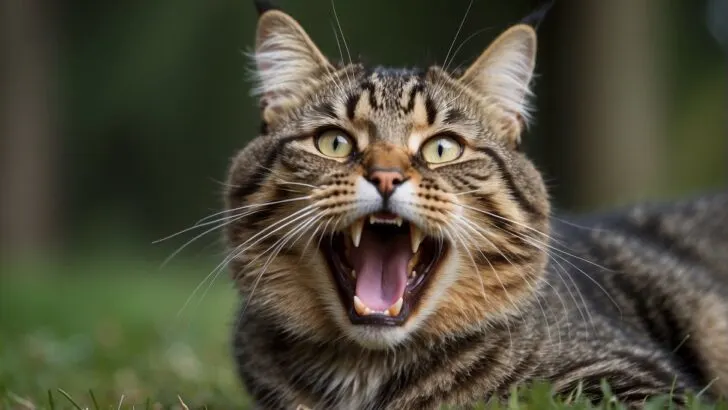Cats hiss as a form of communication, indicating they’re feeling threatened or are in a defensive stance. When you hear that sharp intake of air and the telltale sibilant sound, it’s akin to your feline friend saying, “Back off!” This could happen, for instance, if a new pet is introduced into the home, and your resident cat feels the need to set boundaries.

In the diverse language of feline behavior, hissing is a pretty clear-cut signal that should be respected. Think of it as a warning shot, a line drawn in the sand by your cat to prevent a physical altercation. It’s not uncommon to witness this behavior when a cat is cornered or if they’re approached too quickly by an overzealous admirer.
Causes of Hissing in Cats

When your feline friend hisses, it’s a multifaceted behavior influenced by various stimuli ranging from fear to pain.
Fear and Anxiety
When your cat feels anxious or scared, they may hiss as an instinctive reaction to a perceived threat. This could be anything from an unfamiliar guest in your home to sudden loud noises. They’re essentially saying, “I’m scared; please give me space.”
Pain and Discomfort
Just like humans, cats can get irritable when they’re not feeling well. A hiss might be a signal that they’re experiencing pain or discomfort somewhere in their body, noting that a visit to the vet might be in order.
Defensive Behavior and Territorial Issues
Your cat’s hiss is a powerful defensive sound, often used to establish or maintain territorial boundaries. If another animal encroaches on their space, the hiss serves as a warning—an audio “keep out” sign.
Vocalizations and Body Language
Hissing is one of many vocalizations cats use, accompanied by body language like an arched back or growling. These cues combine to provide a clear message of your cat’s current state, be it defensive, agitated, or otherwise.
Socialization and Environmental Influences
Cats hiss due to social or environmental stressors, such as when a mother cat protects her kittens or during confrontations with other cats. The environment, routines, and social structures they are in can significantly affect their hissing behaviors.
Hissing is not just a simple act of feline defiance; it’s a multifaceted language all on its own.
Responding to a Hissing Cat
When your cat hisses, it’s essential to understand the appropriate responses and measures to prevent escalations. This involves reading warning signs and applying specific techniques to manage their behavior.
Warning Signs and Preventative Measures
Before a cat resorts to hissing, it often exhibits certain body language that signals discomfort or irritation, such as dilated pupils, low energy, hiding, or a tense body. Early recognition of these signs can help you take preventative steps to reduce stress for your feline friend.
For instance, if a new family member or pet has joined the household, giving your cat a safe spot where it can retreat can help them feel secure in a multi-cat environment or amid alterations to its familiar terrain.
- Provide a consistent routine to minimize stress
- Recognize and respect your cat’s personal boundaries
- Introduce any new family member or pet gradually
- Ensure a dedicated safe space for retreat
Training Techniques and Behavioral Correction
The cornerstone of addressing cat hissing involves the twin pillars of training and behavioral correction. Reward-based training can encourage your cat to embrace a low-energy, calm demeanor. Rewards can be small treats, verbal praise, or petting, based on what your cat favors.
Techniques like desensitization, gradually exposing your cat to a stressor in a controlled manner, and counterconditioning, associating the stressor with positive rewards, can be highly effective.
In rarer situations, such as if your cat hisses due to pain which might happen with conditions like arthritis, consulting a vet is necessary to address the underlying health issue. In all cases, avoid negative reinforcements like yelling, punitive gestures, or bursts of air, as these can further agitate your cat and escalate the behavior to biting, scratching, or swatting.
- Use positive reinforcement with rewards for calm behavior
- Practice desensitization and counterconditioning for gradual change
- Seek veterinary advice for potential health-related issues

My name is James, and welcome to FAQCats!
Along with our team of cat owners, expert pet enthusiasts, and pet professionals, we aim to write engaging helpful, engaging content about cats. At FAQCats we strive to provide content that’s accurate and fun to read. Our team writes about everything related to cats; even the most complex of topics. Through extensive research and caring for our own fur-pals, we’re able to provide something cat owners worldwide will love. Have a look around, and leave us feedback anytime!

